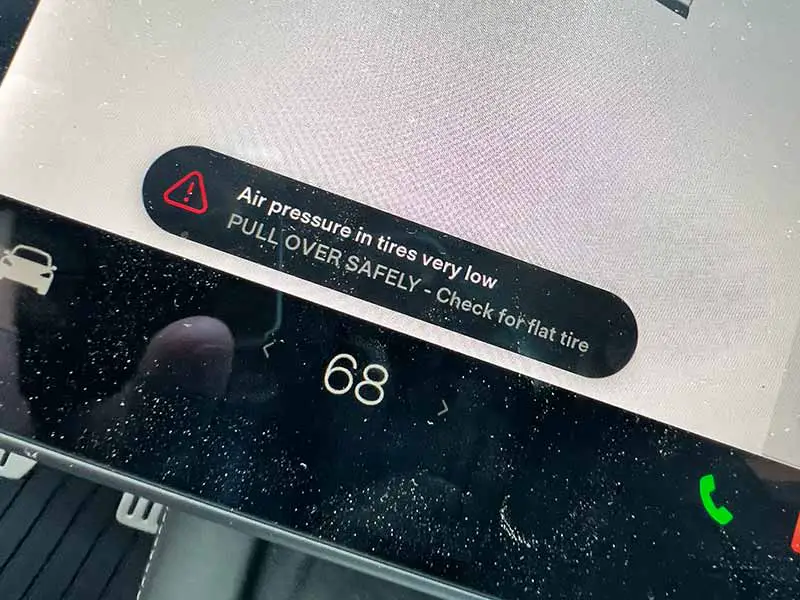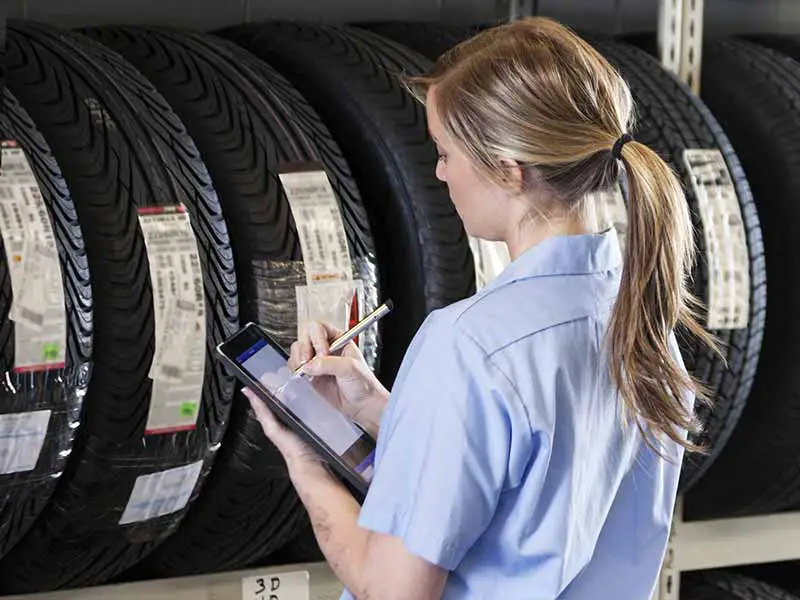Tires are the unsung heroes of our vehicles, gripping the road and ensuring our safety. But with the evolution of tire technology, a debate has emerged: run-flat tires versus regular tires. Which one is truly the best for your vehicle, and why does it matter?
Run-Flat Tires Vs Regular Tires
The difference between run-flat tires and regular tires is that run-flat tires are engineered to maintain their shape and functionality even after a puncture, allowing drivers to continue driving for a limited distance. In contrast, regular tires, while often providing a smoother ride, require immediate attention or replacement upon a puncture.
In this article, we’ll delve deep into the world of tires, comparing the advantages and disadvantages of run-flat and regular tires. From their construction and performance to their impact on safety and cost, we’ll provide a comprehensive overview to help you make an informed decision for your vehicle.
Let’s take a closer look.
What are Run-Flat Tires?
Run-flat tires, often referred to as “self-supporting run-flats,” are a specialized type of tire designed to maintain their shape and functionality even after suffering a puncture. Unlike conventional tires, which can go flat and become unrideable after a puncture, run-flat tires allow drivers to continue their journey for a limited distance at a reduced speed. This unique capability is attributed to their specific construction and technology.
Key Features of Run-Flat Tires
- Reinforced Sidewalls: One of the primary features that distinguish run-flat tires from conventional ones is their reinforced sidewalls. These sidewalls are made of robust and resilient materials, allowing the tire to support the vehicle’s weight even when the tire loses air pressure.
- Self-Supporting Structure: The internal structure of run-flat tires is designed to be self-supporting. This means that even if there’s a puncture causing air loss, the tire’s structure remains intact, preventing it from collapsing under the vehicle’s weight.
- Tire Pressure Monitoring System (TPMS) Compatibility: Run-flat tires are typically paired with a TPMS. This system alerts drivers when there’s a significant drop in tire pressure, ensuring they’re aware of the situation and can take appropriate action.
How Do Run-Flat Tires Work?
When a run-flat tire gets punctured, the reinforced sidewall’s design ensures that the tire doesn’t immediately deflate. Instead, the tire retains its shape, allowing the driver to maintain control of the vehicle. However, it’s essential to note that run-flat tires are not a permanent solution to a puncture. They are designed to provide a temporary fix, granting drivers:
- Safety: The ability to avoid changing a tire on a busy highway or in an unsafe location.
- Convenience: The opportunity to drive to a nearby service station or tire shop for a proper repair or replacement.
- Limited Driving Range: After a puncture, run-flat tires can typically be driven for an additional 50 to 100 miles, depending on the tire’s brand and model. However, this should be done at a reduced speed, usually not exceeding 50 mph.
Considerations for Using Run-Flat Tires
While run-flat tires offer several advantages, it’s crucial for drivers to be aware of their limitations:
- Not a Permanent Fix: As mentioned, run-flat tires are a temporary solution. After a puncture, they should be inspected and repaired or replaced as soon as possible.
- Specialized Repairs: Not all tire shops have the equipment or expertise to repair or replace run-flat tires. It’s advisable to check with local service providers about their capabilities.

Advantages of Run-Flat Tires
Run-flat tires have gained popularity among many vehicle manufacturers and drivers due to the distinct benefits they offer. These advantages not only enhance driving safety but also provide added convenience in various driving scenarios.
Enhanced Safety in Puncture Situations
- Maintained Vehicle Control: When a conventional tire gets punctured at high speeds, it can lead to a sudden loss of control. Run-flat tires, with their reinforced structure, ensure that the vehicle remains stable, allowing the driver to handle the situation more safely.
- Avoiding Roadside Tire Changes: Changing a tire on the side of a busy road can be dangerous. With run-flat tires, drivers can continue to a safer location or a nearby service station, eliminating the immediate need for a roadside tire change.
No Need for a Spare Tire
- Reduced Vehicle Weight: Without the need to carry a spare tire, vehicles equipped with run-flat tires can benefit from reduced weight. This can lead to improved fuel efficiency and additional storage space in the trunk.
- Simplified Vehicle Design: Many modern vehicles are designed without a spare tire compartment, thanks to run-flat technology. This design choice allows for more creative and spacious vehicle interiors.
Limited Distance Driving Post-Puncture
- Temporary Mobility: After suffering a puncture, run-flat tires allow drivers to travel a limited distance (typically 50 to 100 miles) at a reduced speed. This range provides ample opportunity to reach a service station or get to a safe location.
- Peace of Mind: Knowing that a puncture won’t immediately strand them gives drivers added confidence during long trips or when traveling in unfamiliar areas.
Compatibility with Modern Monitoring Systems
- Tire Pressure Monitoring System (TPMS): Run-flat tires are designed to work seamlessly with TPMS. This system provides real-time feedback on tire pressure, alerting drivers to any significant pressure drops and ensuring they’re aware of the tire’s status.
Improved Vehicle Performance
- Stiffer Sidewalls: The reinforced sidewalls of run-flat tires can contribute to a more responsive driving experience. Some drivers prefer the firmer ride and enhanced handling characteristics these tires offer, especially in performance-oriented vehicles.

Disadvantages of Run-Flat Tires
While run-flat tires offer numerous advantages, it’s essential to understand their limitations and potential drawbacks. Being informed about these disadvantages can help drivers make an educated decision about whether run-flat tires are the right choice for their specific needs.
Potentially Rougher Ride
- Stiffer Sidewalls: The reinforced sidewalls that give run-flat tires their self-supporting capability can also result in a firmer, less cushioned ride compared to conventional tires. Some drivers might find this less comfortable, especially on rough or uneven road surfaces.
Limited Repair Options
- Specialized Equipment Needed: Repairing or replacing run-flat tires often requires specialized equipment and expertise. Not all tire shops are equipped to handle run-flat tires, which can limit where drivers can get service.
- Less Likely to Be Repaired: Due to their unique construction, once punctured, run-flat tires are less likely to be repairable compared to conventional tires. This can mean more frequent tire replacements.
Higher Cost
- Price Point: Run-flat tires typically come with a higher price tag than conventional tires. This cost can add up, especially if replacements are needed more frequently.
- Replacement Over Repair: As mentioned, run-flat tires are often replaced rather than repaired after a puncture, leading to potentially higher maintenance costs over the vehicle’s lifespan.
Reduced Availability
- Limited Selection: While the popularity of run-flat tires is growing, they are still not as widely available as conventional tires. This limited availability can mean fewer options when it comes to brands, models, and sizes.
Limited Post-Puncture Driving
- Temporary Solution: While run-flat tires allow for continued driving after a puncture, it’s only for a limited distance and at a reduced speed. Drivers must be cautious and seek a repair or replacement as soon as possible.
Potential for Overlooking Maintenance
- Complacency with TPMS: Because run-flat tires can function even when punctured, some drivers might become complacent and ignore TPMS warnings. Regular tire checks and maintenance are still crucial to ensure safety and tire longevity.

Advantages of Regular Tires
Regular, or conventional, tires have been the go-to choice for the majority of drivers for decades. While run-flat tires offer specific benefits, conventional tires come with their own set of advantages that cater to a broad range of driving needs and preferences.
Comfortable Driving Experience
- Smooth Ride: The flexible sidewalls of conventional tires can absorb road imperfections more effectively than the stiffer sidewalls of run-flat tires. This results in a smoother, more comfortable ride, especially on bumpy or uneven roads.
Cost-Effective
- Lower Initial Cost: Generally, conventional tires are less expensive than run-flat tires. This price difference can be significant, especially when replacing multiple tires.
- Repair Over Replacement: Unlike run-flat tires, which often need to be replaced after a puncture, conventional tires can often be repaired. This can lead to cost savings over the lifespan of a vehicle.
Wide Availability and Variety
- Extensive Options: Conventional tires are available in a vast range of sizes, tread patterns, and brands. This variety allows drivers to find the perfect tire for their specific needs, whether it’s for daily commuting, off-roading, or performance driving.
- Easier to Find Replacements: Given their widespread use, it’s typically easier to find replacements for conventional tires, even in remote areas.
Potentially Longer Lifespan
- Durability: Some drivers find that conventional tires last longer than run-flat tires, especially when maintained properly. Regular checks for proper inflation, alignment, and rotation can extend the lifespan of conventional tires.
Familiar Maintenance and Care
- Standard Repairs: Most tire shops are equipped to repair or replace conventional tires. Drivers don’t need to seek out specialized service providers, as is sometimes the case with run-flat tires.
- Consistent Care Routine: Those who have been driving for years are often more familiar with the care and maintenance routine of conventional tires, making it easier to ensure they remain in good condition.
Resources
Below are some links you may find helpful when learning about tires
- Run-flat tires vs. regular tires: We’ll help you choose – Firestone
- Why do run-flat tires suck? Science, and tradeoffs – Autoweek
Final Thoughts
While run-flat tires offer the undeniable advantage of post-puncture mobility, ensuring safety and convenience, they come with a steeper price tag and potentially rougher ride.
On the other hand, regular tires, with their widespread availability and familiar maintenance routines, offer a balance of performance and comfort.
Ultimately, the best choice is one that aligns with your needs, ensuring both safety and satisfaction on the road.
Good luck and happy motoring.





